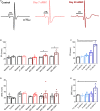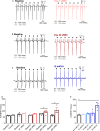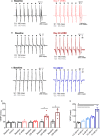Potential Consequences of the Red Blood Cell Storage Lesion on Cardiac Electrophysiology
- PMID: 33086931
- PMCID: PMC7763412
- DOI: 10.1161/JAHA.120.017748
Potential Consequences of the Red Blood Cell Storage Lesion on Cardiac Electrophysiology
Abstract
Background The red blood cell (RBC) storage lesion is a series of morphological, functional, and metabolic changes that RBCs undergo following collection, processing, and refrigerated storage for clinical use. Since the biochemical attributes of the RBC unit shifts with time, transfusion of older blood products may contribute to cardiac complications, including hyperkalemia and cardiac arrest. We measured the direct effect of storage age on cardiac electrophysiology and compared it with hyperkalemia, a prominent biomarker of storage lesion severity. Methods and Results Donor RBCs were processed using standard blood-banking techniques. The supernatant was collected from RBC units, 7 to 50 days after donor collection, for evaluation using Langendorff-heart preparations (rat) or human induced pluripotent stem cell-derived cardiomyocytes. Cardiac parameters remained stable following exposure to "fresh" supernatant from red blood cell units (day 7: 5.8±0.2 mM K+), but older blood products (day 40: 9.3±0.3 mM K+) caused bradycardia (baseline: 279±5 versus day 40: 216±18 beats per minute), delayed sinus node recovery (baseline: 243±8 versus day 40: 354±23 ms), and increased the effective refractory period of the atrioventricular node (baseline: 77±2 versus day 40: 93±7 ms) and ventricle (baseline: 50±3 versus day 40: 98±10 ms) in perfused hearts. Beating rate was also slowed in human induced pluripotent stem cell-derived cardiomyocytes after exposure to older supernatant from red blood cell units (-75±9%, day 40 versus control). Similar effects on automaticity and electrical conduction were observed with hyperkalemia (10-12 mM K+). Conclusions This is the first study to demonstrate that "older" blood products directly impact cardiac electrophysiology, using experimental models. These effects are likely caused by biochemical alterations in the supernatant from red blood cell units that occur over time, including, but not limited to hyperkalemia. Patients receiving large volume and/or rapid transfusions may be sensitive to these effects.
Keywords: cardiac electrophysiology; hyperkalemia; red blood cell storage lesion.
Conflict of interest statement
None.
Figures







Similar articles
-
Cardiac arrests associated with hyperkalemia during red blood cell transfusion: a case series.Anesth Analg. 2008 Apr;106(4):1062-9, table of contents. doi: 10.1213/ane.0b013e318164f03d. Anesth Analg. 2008. PMID: 18349174
-
Red blood cell storage lesion.J Vet Emerg Crit Care (San Antonio). 2015 Mar-Apr;25(2):187-99. doi: 10.1111/vec.12252. Epub 2014 Nov 26. J Vet Emerg Crit Care (San Antonio). 2015. PMID: 25428860 Review.
-
Transfusion-Associated Hyperkalemic Cardiac Arrest in Neonatal, Infant, and Pediatric Patients.Front Pediatr. 2021 Oct 29;9:765306. doi: 10.3389/fped.2021.765306. eCollection 2021. Front Pediatr. 2021. PMID: 34778153 Free PMC article. Review.
-
Transfusion-associated hyperkalemia in pediatric population: Prevalence, risk factors, survival, infusion rate, and RBC unit features.Transfusion. 2021 Apr;61(4):1093-1101. doi: 10.1111/trf.16300. Epub 2021 Feb 10. Transfusion. 2021. PMID: 33565635
-
Longer RBC storage duration is associated with increased postoperative infections in pediatric cardiac surgery.Pediatr Crit Care Med. 2015 Mar;16(3):227-35. doi: 10.1097/PCC.0000000000000320. Pediatr Crit Care Med. 2015. PMID: 25607740 Free PMC article. Clinical Trial.
Cited by
-
The artificial oxygen carrier erythrocruorin-characteristics and potential significance in medicine.J Mol Med (Berl). 2023 Aug;101(8):961-972. doi: 10.1007/s00109-023-02350-3. Epub 2023 Jul 18. J Mol Med (Berl). 2023. PMID: 37460699 Free PMC article. Review.
-
The Effects of Glutathione Monoethyl Ester on Different Biochemical, Oxidant, and Antioxidant Levels During Storage in Leukoreduced Red Blood Cells.Adv Biomed Res. 2024 Nov 30;13:111. doi: 10.4103/abr.abr_169_23. eCollection 2024. Adv Biomed Res. 2024. PMID: 39717241 Free PMC article.
-
Effects of storage duration of suspended red blood cells before intraoperative infusion on coagulation indexes, routine blood examination and immune function in patients with gastrointestinal tumors.Pak J Med Sci. 2023 Jan-Feb;39(1):182-187. doi: 10.12669/pjms.39.1.7031. Pak J Med Sci. 2023. PMID: 36694766 Free PMC article.
-
Toward Translational Impact of Low-Glucose Strategies on Red Blood Cell Storage Optimization.ACS Pharmacol Transl Sci. 2024 Feb 22;7(3):878-887. doi: 10.1021/acsptsci.4c00018. eCollection 2024 Mar 8. ACS Pharmacol Transl Sci. 2024. PMID: 38481682 Free PMC article.
-
Nanoscale Changes on RBC Membrane Induced by Storage and Ionizing Radiation: A Mini-Review.Front Physiol. 2021 Jun 4;12:669455. doi: 10.3389/fphys.2021.669455. eCollection 2021. Front Physiol. 2021. PMID: 34149450 Free PMC article. Review.
References
-
- Jonas RA. Comprehensive Surgical Management of Congenital Heart Disease. London: Hodder Education Group; 2004.
-
- Speiss BD. Transfusion and outcome in heart surgery. Ann Thorac Surg. 2002;74:986–987. - PubMed
Publication types
MeSH terms
Grants and funding
LinkOut - more resources
Full Text Sources
Other Literature Sources
Medical

